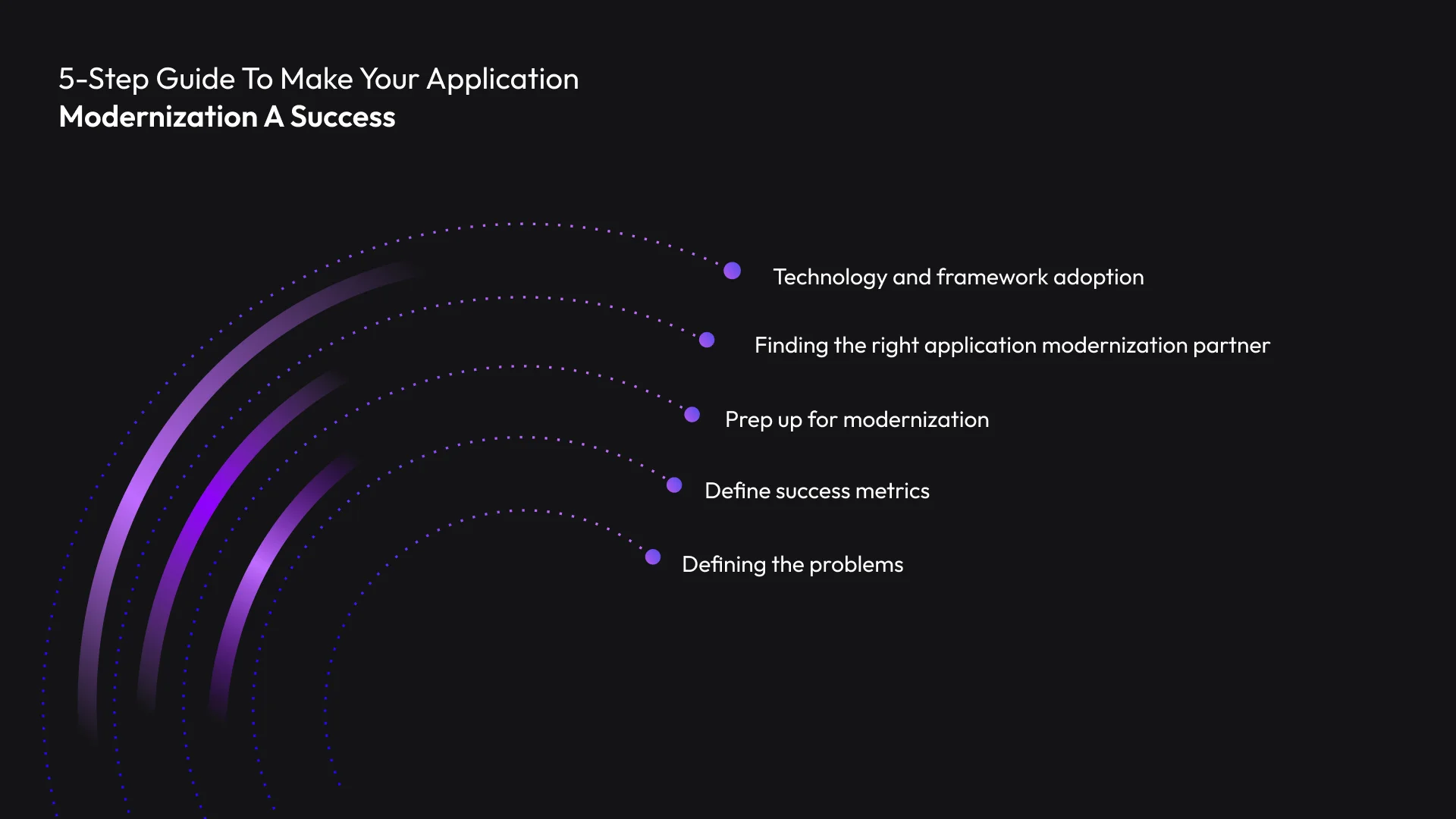Data Storage Decoded: Data Warehouse vs Data Lake Explained
Why Leading Businesses Are Prioritizing Application Modernization
Technology is evolving at an accelerated pace, and businesses need to modernize to stay ahead of the emerging trends. Continuing with legacy systems can significantly hinder business growth and cause financial losses. It also makes your organization vulnerable to security threats and affects productivity.
Rather than losing money with an old system, why not modernize it and supercharge your business performance?
Application modernization is a strategic approach to enhancing customer experience, strengthening security, and fueling revenue. Discover the importance of application modernization and why it should be a priority. This article outlines the best strategies for application modernization and explains how a digital transformation company can seamlessly guide you through the process.
What is Application Modernization?
Application modernization primarily refers to upgrading legacy or old software systems and applications by leveraging modern frameworks, technologies, infrastructure, and tools. This process involves updating your systems to improve application performance and align with changing business needs. Application modernization uses advanced technologies such as cloud computing, blockchain, and artificial intelligence to move your existing applications to new platforms based on microservices architecture.
Why Application Modernization is Now a Top Priority
Business owners are sometimes skeptical about modernizing their applications, fearing data loss and the need to start from scratch. However, app modernization is more like renovating a house. You don't need to replace your older system entirely; instead, you revamp and remodel it to increase efficiency while retaining the existing memory and data.
The Market Research Future's predictions reveal that the global market size for app modernization will reach $38.7 billion at the end of 2032. The figure indicates a compound annual growth rate (CAGR) of 16.5% between 2024 - 2032. Legacy applications pose several challenges that make it difficult for organizations to carry out their day-to-day operations.
Primary Challenges of Legacy Applications:
Security risks
Traditional security measures have major drawbacks that make them less effective in today's rapidly changing IT security environment.
Lacks scalability
Most legacy applications have a limited space to handle a specific amount of workload or size of data. It hampers an organization's ability to grow and scale its business.
Limited capabilities
Traditional systems can perform only a few tasks or functions, which is why organizations find it difficult to adapt to evolving business needs.
High maintenance costs
Because legacy systems are old and have different features and functionalities, they require specialized skills and high maintenance costs.
If your organization is growth-driven and practices a forward-thinking approach, here are some compelling reasons to kickstart your application modernization journey.
Top Benefits of Application Modernization:
A survey on 1420 global companies released by Statista in 2023 cited security, efficiency, cost, reduction, and modern tech integration as the driving factors for existing application modernization.
Apart from these, increased agility and greater scalability are two reasons for global companies to shift to modern structures and remodel their existing applications.
Key Reasons Driving Application Modernization of Companies Worldwide

Heightens Security
Outdated software with weak security is a prime target for hackers and cyber attackers. Lack of adequate security layers and patches makes it difficult to protect from online threats, resulting in data breaches, financial losses, and reputational damage.
Adopting application modernization is not just about leveling up its performance with new features and enhanced functionality. It fortifies your application against potential security threats and vulnerabilities.
Furthermore, upgrading your app to the latest security measures helps you comply with industry standards.
Cost and Time Savings
The next significant advantage that makes application modernization a must for every organization is cost and time efficiency. Maintaining legacy applications and outdated infrastructure is both expensive and time-consuming. The older an application is, the higher the maintenance costs.
Legacy systems can cost organizations 80% more maintenance and support than modern cloud-native applications.
Here's where application modernization steps in to save the day. While it requires an initial investment, it significantly cuts down on long-term maintenance costs, ultimately saving you money.
Operational Efficiency
According to a Deloitte report, 73% of organizations cite improving operational efficiency as a primary driver for application modernization. Integrating modern platforms and re-architecting legacy apps to the modern cloud platform enhances efficiency and assists organizations in keeping pace with emerging business requirements.
Integrating automation tools lowers the chances of errors and saves time by processing repetitive manual tasks faster. Hence, businesses can focus more on higher-value and business-critical operations that require human intervention.
Enhanced User Experience
Outdated applications often feature clunky and complicated user interfaces, which can drive users away. System downtime, security issues, and network latency are some of the reasons that frustrate users, compelling them to transition to updated and modern applications.
An elegant, contemporary design paired with an intuitive, speedy interface significantly boosts conversion rates. This delivers customers a seamless, captivating user experience, leaving a lasting impression.
Enhances Scalability
Traditional systems lack scalability and adaptability, which limits their functions. Remodeling your application can help you overcome scalability issues and performance bottlenecks. Cloud migration and integration of Artificial intelligence and other emerging technologies can make your application scalable and flexible.
Moreover, it helps you stay competitive and keep abreast of trends. More than 90% of new applications built on cloud infrastructure enable scalability, faster development, and cost efficiency. There is no denying that application modernization has become a critical need for many organizations to stay relevant and future-ready. If you want your business to stay updated and retain customers, here's what you need to do before moving forward with application modernization.
Defining business goals
Evaluate your business requirements and determine the goals your business aims to achieve through application modernization.
In-depth application observation
Deep observation and analysis of your existing application are necessary steps for app remodeling. They help you get a clear picture of your user behavior and dependency interactions.
Adopt Automation
The application modernization process is complex, and teams often struggle to scale across an application infrastructure. Employing automation is effective in designing a repeatable pipeline for app restructuring.
Regular updation and maintenance
App upgrade and modernization are never-ending processes. Frequent updates and maintenance can help you stay current with evolving technology and market conditions.
Leading Businesses That Already Embraced App Modernization
Here are top real-world examples of global brands that have already embraced application modernization and are reaping its benefits.
Walmart
Walmart completely revamped its eCommerce platform and migrated to a modern cloud platform. Its microservices-based architecture accelerated the development and deployment of new features and updates.
The outcome?
The transformation improved the platform's scalability and enhanced customer experiences.
McDonald's
McDonald's is one of the first brands to introduce digital ordering and payment systems by migrating to the cloud-native architecture. Further, it made some enhancements and integrated new features.
This intelligent move instantly elevated overall customer experiences and helped them gain a competitive edge in the digital space.
Capital One
Capital One, the top financial institution in the US, modernized its monolithic application by utilizing Docker containers and leveraging cloud infrastructure. They decoupled apps using microservices, enhancing performance and heightened security.
5-Step Guide To Make Your Application Modernization A Success
For many business owners, the journey of app modernization might seem overwhelming. However, with careful planning and a comprehensive approach, you can move forward with app modernization and attain success.
Four stages to follow to craft a successful app modernization strategy are -
Defining the problems
Identify the challenges or issues necessitating the app modernization process.
Preparing for modernization
Assess the current application landscape, gather requirements, and plan for the necessary steps and resources.
Technology and framework adoption
Evaluate and select the appropriate key technologies, frameworks, and architectures to align with the modernization goals.
Define success metrics
Establish clear and measurable criteria to gauge the success of the modernization efforts.
Finding the right application modernization partner
Identify and partner with a reliable, competent service provider to support and guide the modernization journey.

How Can Sundew Help?
Sundew offers unparalleled expertise to facilitate your journey. With nearly two decades of digital transformation experience, our team excels at streamlining the complexities of modernization.
From strategy selection to system transformation, our approach is customized to suit your business's unique needs and objectives, ensuring a seamless transition from existing applications. With Sundew by your side, your journey to modernization is in capable hands.
Wrapping Up
Prioritizing application modernization can be a path-breaker in positioning your organization for future success. It is a strategic investment that can drive conversions and revenue generation. Start by assessing your current software or application landscape to identify areas that need improvement.
Businesses can boost performance, minimize security risks, and reduce cost, ultimately staying competitive and delivering engaging user experience.
Email us or Talk to us at +91-98367-81929 or Simply Contact Us through the website.
Let's Connect












